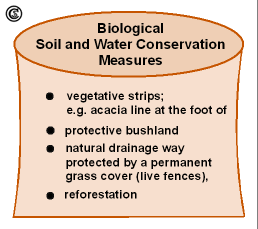Biological soil and water conservation measures
Selection of biological soil and water conservation measures applied in WM
Image Credit: Anette Stumptner 2007, after data from Krüger 1997; Lal 1995.
Biological measures for soil and water conservation work by their protective impact on the vegetation cover. A dense vegetation cover
These effects entail a low soil erosionrate compared with an uncovered soil which shows in general a high soil erosion rate. Even cultivated crops in agricultural areas are a better protection against soil loss than uncovered soil (relatively high soil erosion rate) [27]. Other positive impacts have been observed, such as improved soil moisture condition (or protection against erosion by wind).
Thus, biological measures are an effective method of soil and water conservation, especially since they are low in cost [13]. Additionally, these can be used with structural and agronomic measures.
Several types of biological soil and water conservation measures exist (see figure).
Afforestation is presented on the following page.



